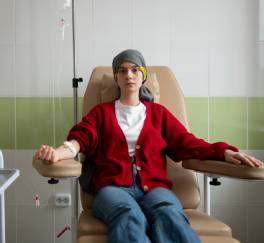 Book Appt.
Book Appt.
 Call Now
Call Now


Sickle cell anemia is a genetic disorder referred as sickle cell disease when clinical symptoms are present. It changes the structure of red blood cells, which transport oxygen throughout the body. Red blood cells are typically spherical and flexible, allowing them to readily pass through blood channels. In sickle cell anemia, certain red blood cells resemble sickles or crescent moons. These sickle cells also become hard and sticky, slowing or preventing blood flow. The current therapeutic strategy aims to alleviate discomfort while also preventing further complications. However, modern medicines may be able to cure people with the illness.
Symptoms
Symptoms of sickle cell anemia often show about 6 months of age. They differ from person to person and can alter over time. Symptoms may include anemia, discomfort, swelling of the hands and feet, recurrent infections, delayed growth or puberty, and eyesight issues.
Causes
Sickle cell anemia is caused by a genetic alteration that tells the body to make hemoglobin. Red blood cells have hemoglobin, an iron-rich chemical that helps them transfer oxygen from the lungs to the rest of the body. The hemoglobin found in sickle cell anemia causes red blood cells to become hard, sticky, and malformed. For a child to have sickle cell anemia, both parents must carry one copy of the sickle cell gene and transmit it on to the child.
If only one parent transmits the sickle cell gene to the child, the youngster will get the sickle cell characteristic. People with the sickle cell trait produce both typical and sickle cell hemoglobin, as they have one typical hemoglobin gene and one sickle cell gene. Their blood may include sickle cells, although they rarely exhibit symptoms. They are carriers of the disease. This means they can pass on the gene to their children.
Risk factors
For a newborn to have sickle cell anemia, both parents must inherit the sickle cell gene. In the United States, sickle cell anemia is most common in people of African, Mediterranean, and Middle Eastern heritage.
Complications
Sickle cell anemia can cause a variety of consequences, such as stroke, acute chest syndrome, pulmonary hypertension, organ damage, splenic sequestration, blindness, leg ulcers, gallstones, priapism, deep vein thrombosis, and pregnancy issues.
Prevention
If you have the sickle cell trait, it is advisable to visit a genetic counselor before becoming pregnant. A counselor can help you understand the chances of having a child with sickle cell anemia. You can also learn about potential treatments, prevention measures, and reproductive alternatives.
Diagnosis
A blood test can detect the type of hemoglobin that causes sickle cell anemia. This blood test is part of the standard newborn screening process in the United States. Nevertheless, adults and older children are welcome to take this test. Adults' blood is obtained from a vein in the arm. Blood is usually obtained from the finger or heel of young children and infants. The sample is subsequently taken to a laboratory and checked for sickle cell hemoglobin. If you or your kid has sickle cell anemia, your doctor may recommend further testing to look for potential problems.
Treatment
The primary goal of sickle cell anemia management is to eliminate pain episodes, alleviate symptoms, and prevent consequences. Drugs and blood transfusions may be used as treatments. A bone marrow transplant may be able to cure children's and teenagers' diseases. Gene therapies are also being explored, which may lead to cures for sickle cell disease. In the treatment, medications such as hydroxyurea (Droxia, Hydrea), L-glutamine oral powder (Endari), crizanlizumab (Adakveo), voxelotor (Oxbryta), and pain-relieving drugs are employed.
Self care
The following steps to stay healthy might help you avoid complications of sickle cell anemia:
Take folic acid supplements daily and eat a nutritious diet.
Drink a lot of water.
Avoid high temperatures.
Exercise regularly, but do not overdo it.
Take medications with caution.
Don't smoke
Conclusion
Sickle cell anemia is a complex and deadly genetic blood condition characterized by abnormally shaped red blood cells caused by a mutation in the hemoglobin gene. This illness causes a variety of symptoms, including persistent anemia, painful crises, an increased risk of infection, and potential consequences affecting several organs.
SHALBY Sanar International Hospitals provides extensive medical procedures backed up with our state-of-the-art technology and a team of highly qualified & experienced clinical experts.
Our doctors pen down their research findings and experiences from time to time. Their words provide deep insight into the latest techniques, technologies and other advancements in healthcare. It provides expert answers to all kinds of health questions for real-life issues.
VIEW ALL



.jpg)
Since the day of its foundation, SHALBY Sanar International Hospitals is committed to provide comprehensive healthcare services. It regularly organizes awareness programs in its premises and encourages outdoor healthcare activities and camps with an intent to put focus on preventive healthcare.
VIEW ALL